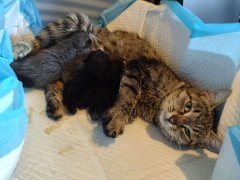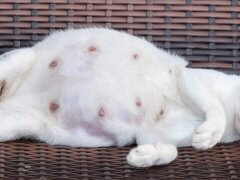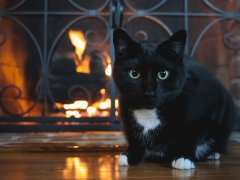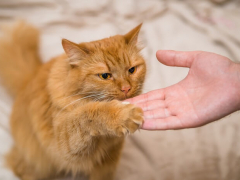
Kirsten McCarthy / Cats.com
Commercial cat foods marketed as ‘complete’ are required to contain all the essential nutrients that your pet needs to thrive without any additional food source. As well as macronutrients such as protein and fats, this also includes various micronutrients, including minerals.
These are vital for a cat’s health and wellness, with functions including bone and tooth growth and the functioning of the nervous system. Cats have specific dietary requirements for certain minerals, and so most commercial cat foods are fortified with mineral mixes to ensure their nutritional needs are met.
What Minerals Do Cats Need?
There are certain minerals that are absolutely essential for your cat’s health.
1. Calcium and Phosphorus
Calcium and phosphorus are both essential nutrients in the formation and maintenance of strong bones and teeth. Calcium is also needed for muscle contraction, blood clotting, nerve function, enzymes and more, while phosphorus is used in muscle use and energy production.
2. Potassium
Potassium is necessary for a stable heart rhythm and is also used in muscle contraction and the vital functions of nerves.
3. Sodium and Chloride
Essential for maintaining correct fluid balance in the body, sodium and chloride help with the maintenance of normal cellular function.
4. Magnesium
Bone health, muscle function, and enzyme and hormone health all require the correct balance of magnesium in the body.
5. Trace Minerals
There are six minerals – copper, iodine, iron, manganese, selenium and zinc – that are essential for a range of bodily functions but are only required in very small amounts by our cats.
Why We Need Minerals in Commercial Cat Food

Calcium is an essential mineral for many species, including cats. Kirsten McCarthy / Cats.com
Commercial cat nutrition is designed to provide our cats with everything they need from their diet, in one handy package and in the correct proportions for optimal health and well-being. Minerals are hugely important for multiple functions in the body, including growth, heart health, cell function, immune support, metabolism, muscle use, and nerve function.
By including minerals above a minimum value in commercial cat food, we can prevent deficiencies and the associated health problems. Using ingredients that contain key minerals can also support a cat’s specific needs at different life stages, such as during early growth, pregnancy, and lactation.
“Providing the right balance of vitamins and minerals is just as important as protein or calories in a cat’s diet. Even small imbalances—especially in minerals like calcium, phosphorus, and potassium—can lead to serious long-term health issues,” says UK-based veterinary nutritionist Emma Passman.
Do All Cats Need All These Minerals?
These minerals are all essential for health, but cats will need differing amounts of them throughout their lives. Calcium, for example, is needed in larger proportions during kittenhood when bone growth is rapid and during lactation.
A complete food provides all the nutrients – protein, fat, carbohydrate, vitamins, and minerals – that your cat needs, meeting the minimum levels set by AAFCO. A balanced diet provides all of your cat’s essential nutrients in the correct proportions for their age and lifestyle.
Do All Cat Foods Contain These Minerals?

Diets marketed as ‘complete’ should contain all the minerals that cats need to thrive. Kirsten McCarthy / Cats.com
All commercial cat foods that are branded as ‘complete’ should contain these essential minerals. In the US, commercial cat foods should comply with guidelines set by the Association of American Feed Control Officials (AAFCO), who set minimum levels of both macro and micronutrients in pet food, including mineral content.
However, compliance with these guidelines isn’t always perfect amongst pet food manufacturers. A study in 2013 of dry dog diets found that 13% did not comply with AAFCO mineral ranges. A larger UK study from 2017 looking at cat and dog diets in both wet and dry forms found that only 6% of wet and 38% of dry diets were fully compliant within the recommended ranges of all 11 mineral nutrient guidelines by FEDIAF (European Pet Food Industry Federation) standards.
Some foods did not provide enough of certain minerals, potentially leading to deficiencies. These can be incredibly damaging to health. A deficiency of calcium (hypocalcemia) in the body, for example, will start with signs such as restlessness, weakness and muscle tremors, but can progress to seizures, coma, and death. Not enough potassium (hypokalemia) causes muscle weakness but can also cause serious heart problems.
Some of the tested foods provided too much of certain minerals, which can also lead to health problems. Many AAFCO recommendations have a minimum dietary inclusion level for these nutrients, but often no maximum. Too much of a good thing can be bad, however. For example, high dietary phosphorus levels, and especially a low calcium to phosphorus (Ca:P) ratio, may be a contributing factor to chronic kidney disease in cats. Studies have found a significant number of commercial cat diets contain higher than recommended levels of phosphorus and variable Ca:P ratios.
Choosing a Cat Food With the Right Minerals
So how do you know if your cat’s diet is meeting their nutritional requirements for minerals? It’s easy to get confused by pet food labels mentioning phrases such as ‘crude protein’, ‘dry matter basis, ’ or ‘ash content. ’
“Choosing a complete and balanced food from a reputable manufacturer that follows AAFCO or FEDIAF guidelines is key to supporting your cat’s lifelong health,” is the advice from nutritionist Emma Passman.
Here are some simple tips to help:
- Choose a diet which is clearly labelled as ‘complete’ (i.e. fulfils all their nutritional needs) and one that is suitable for their age and lifestyle
- Check that the diet has the AAFCO nutritional adequacy statement
- Cats are obligate carnivores, so the bulk of their diet should be based on animal protein. The first ingredient (i.e., the most plentiful) should, therefore, be a high-quality animal protein and should be named (i.e., beef, chicken or salmon).
- Most commercial diets include a mix of vitamins and minerals, which should be listed.
Commercial cat foods that are nutritionally complete, based on high-quality animal protein, don’t contain a lot of unnecessary ingredients such as sweeteners, artificial flavors, or thickeners and follow AAFCO guidelinesand should contain the right balance of minerals for your cat to thrive.







